Pabst Snap Quart: circa 1955
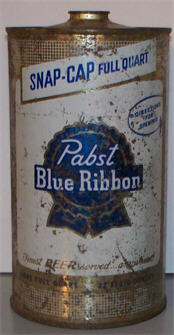 |
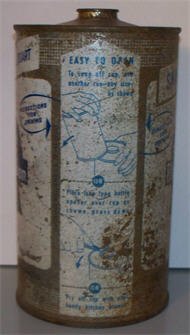 |
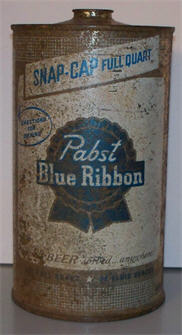 |
Let's look at another quart can this month, a Pabst "Snap-Cap" from the 1950s. Quart cans were introduced in the 1930s but were losing favor by the mid 1950s. American Can Company developed this variation of the quart can and several brewers used it, most notably Pabst. This quart was part of a period when there was a lot of experimentation with beer cans as brewers attempted to find new markets. The 1950s also saw the successful introduction of the 7, 8, 10, 11, 15 and 16 oz cans. The end of the decade witnessed the first aluminum cans, the first aluminum tops, and, in 1962, the pop top can that didn't need an opener.
Snap-Top Quarts
The "Snap-Cap" can was designed to overcome the main disadvantage of existing quart cans, the tall cone at the top. Cone top cans were slowly losing market share to flat top cans, which took up less space and could be easily stacked in stores and in refrigerators. Some of the original quarts in the 1930s had been flat tops, but they had their own problem. The carbonization in beer required a heavy gauge of metal in the tops and bottoms, but this made opening them with a churchkey difficult. By taking advantage of the concave bottom, and developing a much lower profile cone, the new Snap-Cap quarts could use a bottle cap, but still be stacked.
One unusual selling point for the can was that you could pop off the cap by using the rim of another can. The can's side panel showed you how, and the cans were sold not only individually, but also in 2 packs. You could also use a standard opener to remove the cap.
 |
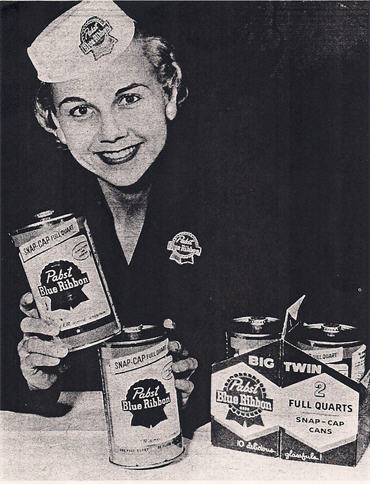 |
Photos Above:
Left: The side panel showing how to use the rim of one can to open another.
Right: "Denise Fisher, attractive guide at Pabst's Milwaukee brewery, demonstrates how to wedge the bottom of one can against [the] crown to pop open the new Pabst full-quart, 'Snap-Cap' can. Also shown is the firm's 'Big Twin Pack,' a carton that holds two of the new quart can, or '10 delicious glassfuls.'"
The cans required a thinned profile cap that was strong enough to stay attached, but could still be easily removed. In the photo below the "Snap Cap" is on the left, while the normal bottle cap is on the right. You can see how much thinner it is. According to an ad in Brewers Digest (May 1956) the new caps were developed by Consolidated Cork in Brooklyn.
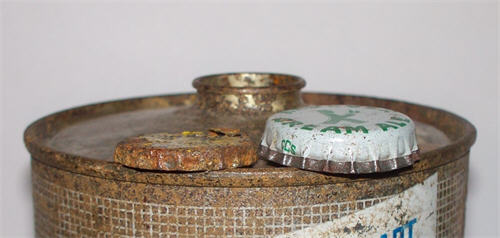 |
Only a few brewers besides Pabst adopted the Snap Cap quart. Two California brewers, Lucky Brewing and San Francisco Brewing also adopted the can. It required special equipment to fill which probably discouraged other brewers from adopting it.
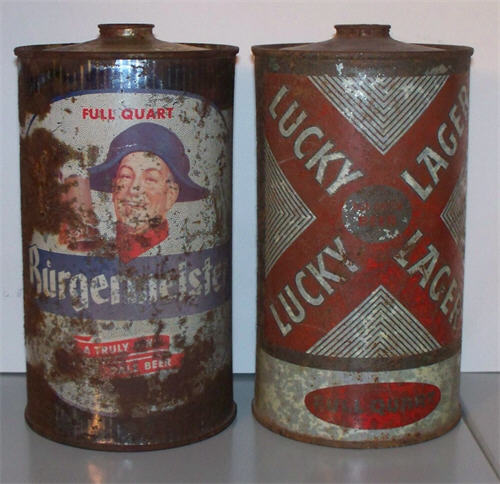 |
Pabst used it the longest. In 1958 they switched their label to a red, blue and silver design, including on their quart cans. This is the hardest of the Pabst quarts to find, so I suspect that its production was short-lived. They filled the quart at their three breweries--Milwaukee, Newark and Los Angeles, although production in their California plant seems to have ended before it did at the other two. (If the USBC is correct). There are four different labels on the Pabst quarts: the gold one shown above, a blue, gold and white label, a silver, blue and white label, and the just-mentioned red, blue and silver can.
Sources Used
"Pabst Introduces 'First Major Beer Packaging Development Since 1935'" Modern Brewery Age (November 1955)
"Quart Cans and the 'Snap-Cap'" Brewers Digest (November 1955)
